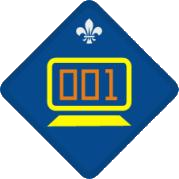Computer Badge
From 6th Kowloon Scout Group Wiki
| Badge | Computer (電腦) |
|---|---|
| Group | Pursuit |
| Application | Intranet Application |
Requirements
Basic level worth 1 mark, Advance level worth 2 marks, Expert level worth 3 marks.
In order to pass, candidate must
- Pass Basic level in all items.
- Get at least 15 marks in total.
- Understand the difference between hardware and software in computer system.
- Basic
- Know the difference
- Advanced
- CPU components
- CPU execution cycle
- Expert
- CPU Pipelining (Why, how, problems and solutions)
- Basic
- Understand the function of hardware, e.g. input / output device and main / secondary storage
- Basic
- Name some I/O devices and storage devices.
- Advanced
- Memory hierarchy
- Random access vs. sequential access
- Two type of RAM
- Expert
- JK Flip-Flop, SR Flip-Flop, D Flip-Flop, T Flip-Flop
- Basic
- Understand the function of operation software and application software, and the relation between hardware, operation software, application software and user.
- Basic
- Understand the function and relation.
- Advanced
- Program vs. Process
- Library call vs. System call
- File system
- Expert
- Process Vs. Thread
- Process Synchronization (Race condition, Mutual exclusion, Critical section, Semaphore, Atomic operation, Deadlock)
- Basic
- Understand the connection method of the Internet, including wireless and broadband, and how data is transferred through the Internet.
- Basic
- Understand the basics.
- Communication Model (Client-Server, P2P, Hybrid)
- Advanced
- FDMA, TDMA, CDMA
- Signal attenuation, hidden terminal problem
- TCP/IP Protocol Stack (responsibility of each layer)
- Expert
- CDMA/CD, CDMA/CA
- How HTTP / FTP / BT works (Choose two)
- Basic
- Understand the social implications of the Internet development. Compare the pros and cons between Internet and traditional information transfer method and know the pros and cons of freedom of information on the Internet.
- Basic
- As titled. (Example: Copyright, Research, Plagiarism, .etc)
- Advanced
- N/A
- Expert
- N/A
- Basic
- Know how to install and use different kind of filtering software, and filter out websites not suitable for children and young people to far away from objectionable materials transmitted on the Internet.
- Basic
- Name some filtering software.
- Name some website not suitable for children.
- Name some ways that children maybe exposed to those website.
- Advanced
- Name some ways that you as a (1)parent (2)system administrator can prevent children from accessing objectionable materials in the Internet.
- Expert
- Know how to set iptables.
- Basic
- Complete either practical training.
- Website Construction
- Recognise the essential factors to be considered in web design
- Basic
- Name some factors
- Advanced
- Know HTML, CSS, JS
- Expert
- Know HTML5, CSS3
- Basic
- Be able to connect to the Internet and be aware of the technologies underlying the operation of the Internet, including the roles of the service providers, the types of connection and access, the use of domain names and domain name servers;
- Basic
- TCP vs. UDP
- DNS
- TCP/IP Protocol Stack (responsibility of each layer)
- Know how HTTP, FTP, BT works
- Advanced
- TCP 3-way handshake and 4-way handshake
- Expert
- Details about TCP (structure, flags, seq number, ack number, ...)
- Basic
- Understand the needs and general requirements of setting the computer network in home, school or troop; and
- Basic
- Different types of network. (bus, star, ring)
- Virtual circuit vs. Datagram Network
- Switch vs. Router
- Advanced
- IP addresses. (Class A B C, Private IP, sub-netting)
- NAT
- Expert
- MTU, IP fragmentation
- Address Resolution Protocol
- Basic
- Design and construct a website with a particular theme, including dynamic web pages with interactive and special effects, and upload onto the World Wide Web. (Web page design should consider the organization of information including ease of navigation, appropriate placement of links, tables, fames and multimedia elements, colour combinations, background design, font size and style, for intended audience.)
- Basic / Advanced / Expert graded according to the quality of the site.
- Topic will be assigned beforehand
- Recognise the essential factors to be considered in web design
- Software Development
- Understand the importance of good programming habits, such as use of meaningful variables, comments, annotations, space and indentation;
- Basic
- As titled.
- Advanced
- Object-oriented programming basic
- Expert
- Object-oriented programming details
- Basic
- Know the Boolean logic (AND, OR, NOT) and truth tables;
- Basic
- Truth table of AND, OR, NOT
- Can derive truth table from the basics
- Advanced
- Circuit diagram.
- Can derive truth table from circuit diagram
- Expert
- Know how to solve boolean algebra.
- Basic
- Understand the procedures of problem solving (Problem identification, problem analysis, designing an algorithm, developing a solution, debugging and testing and documentation); and
- Basic
- Know the steps and why.
- Advanced
- Different changeover methods. Pro and cons.
- Expert
- Waterfall model Pro and cons
- Agile software development Pro and cons.
- Basic
- Use one of the computer language, with variable, operator and flow control, etc, to develop a specified programme (including input and output function).
- Basic / Advanced / Expert graded according to the quality of the program.
- Topic will be assigned beforehand
- Understand the importance of good programming habits, such as use of meaningful variables, comments, annotations, space and indentation;
- Website Construction
